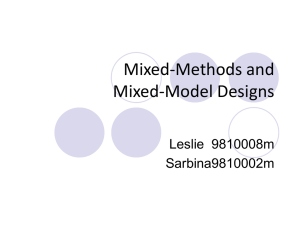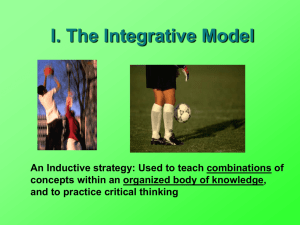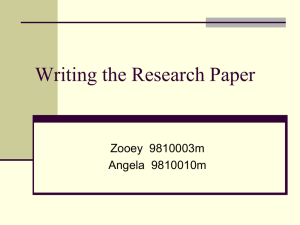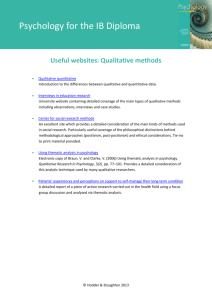View paper
advertisement
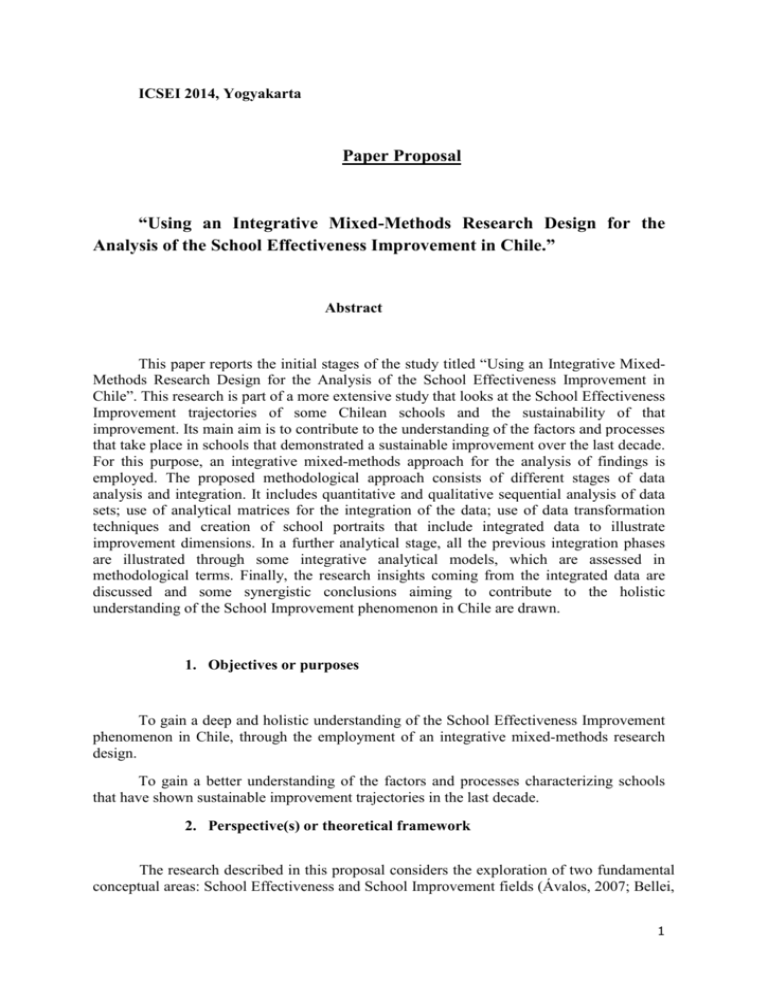
ICSEI 2014, Yogyakarta Paper Proposal “Using an Integrative Mixed-Methods Research Design for the Analysis of the School Effectiveness Improvement in Chile.” Abstract This paper reports the initial stages of the study titled “Using an Integrative MixedMethods Research Design for the Analysis of the School Effectiveness Improvement in Chile”. This research is part of a more extensive study that looks at the School Effectiveness Improvement trajectories of some Chilean schools and the sustainability of that improvement. Its main aim is to contribute to the understanding of the factors and processes that take place in schools that demonstrated a sustainable improvement over the last decade. For this purpose, an integrative mixed-methods approach for the analysis of findings is employed. The proposed methodological approach consists of different stages of data analysis and integration. It includes quantitative and qualitative sequential analysis of data sets; use of analytical matrices for the integration of the data; use of data transformation techniques and creation of school portraits that include integrated data to illustrate improvement dimensions. In a further analytical stage, all the previous integration phases are illustrated through some integrative analytical models, which are assessed in methodological terms. Finally, the research insights coming from the integrated data are discussed and some synergistic conclusions aiming to contribute to the holistic understanding of the School Improvement phenomenon in Chile are drawn. 1. Objectives or purposes To gain a deep and holistic understanding of the School Effectiveness Improvement phenomenon in Chile, through the employment of an integrative mixed-methods research design. To gain a better understanding of the factors and processes characterizing schools that have shown sustainable improvement trajectories in the last decade. 2. Perspective(s) or theoretical framework The research described in this proposal considers the exploration of two fundamental conceptual areas: School Effectiveness and School Improvement fields (Ávalos, 2007; Bellei, 1 2009, 2010, 2013; Chapman et al., 2012; González & Bellei, 2013; Teddlie & Reynolds, 2000; Townsend, 2007). Nevertheless, for the specific purposes of this study, which main aim emphasises the use of an integrative mixed-methods research design for the understanding of the School Improvement phenomenon in Chile, the exploration of the mixed-methods literature and theoretical development is given special importance. In the last decade, the use of mixed methodologies in social sciences and educational research has increased in popularity and sophistication (Tashakkori & Teddlie, 2010; Teddlie & Tashakkori, 2009; Creswell, 2009; Gorard & Taylor, 2004; Sammons, 2010). Mixed methodologists argue that this approach improves the quality of the research findings, strengthening the validity, reliability and trustworthiness of the research inferences and contributing to the better understanding of a phenomenon by giving a more holistic and complete picture of it (Day et al., 2006, 2008; Jang et al., 2008; Kington et al., 2011; Sammons et al. 2005, 2007). The exploration of the theory produced in the area provides a solid framework to situate the research. It also contributes to the development of conceptual elaborations or new models through the revision of the existent models and the connection of them with the findings of this research. In summary, the theoretical exploration is fundamental for the elaboration of integrative mixed-methods models that contribute to the understanding of the School Effectiveness Improvement in Chile. 3. Methods and techniques As already stated, this research employs an integrated mixed methodology to address the School Effectiveness Improvement in Chile. The methodological design includes many stages of data analysis and integration. Firstly, a separate analysis of the quantitative and qualitative data is performed. The quantitative part includes the creation of longitudinal databases of students’ academic outcomes, as well as, data sets on students and schools’ characteristics. In the analysis of data, some complex statistical techniques such as multilevel multiple regression are employed. In the qualitative part, school case-studies are undertaken. The main sources of qualitative data are semi-structured interviews and observation records. In this specific research, the analysis of both strands is not parallel, but sequential and the integration starts in the qualitative part, since new research questions have been raised after the quantitative analysis, which has implied a more in-depth exploration. The next phase of integration includes the use of analytical matrices or tables to analyse quantitative and qualitative data (Balbontín, 2012; Day et al., 2006). In order to integrate both types of data, data transformation strategies are used (Creswell, 2009; Creswell & Plano Clark, 2007; Teddlie & Tashakkori, 2009). A third integration stage includes the creation of school portraits which integrate quantitative and qualitative data. In this phase the quantitative data is mostly transformed, since the schools’ stories are presented in a narrative way. A further analytical stage consists on the presentation of integrative analytical models that illustrate the previous integration phases. 2 Finally, an in-depth discussion about the findings coming from the integrated data and some synergistic interpretations are presented. 4. Data sources or evidence The quantitative sources of evidence are national databases that provide longitudinal information about students’ academic outcomes and about schools and students characteristics. The qualitative sources of evidence are semi-structured interviews and observation records, which are analysed as part of the case-studies. 5. Expected Results It is expected that the employment of a mixed-methods research design in this study may contribute to a more effective understanding of the School Effectiveness Improvement phenomenon in Chile. 6. Educational importance for theory, practice, and/or policy This research represents a theoretical and methodological advance in the Chilean context because the use of integrative mixed-methods has been almost unexplored in educational research. The findings of this research will inform policy makers and practitioners, since the improvement of the educational quality is one of the most important issues in the current political agendas. 7. Connection to the themes of the congress This particular study can be connected with the following conference theme: School Effectiveness, School Improvement and School Transformation–What do they Mean in Different and Different Paradigms. References Ávalos, B. (2007) School Improvement in Latin America: Innovations Over 25 Years (1980-2006). En: Townsend, T. (ed.) (2007) The International Handbook of School Effectiveness and Improvement. Dordrecht, The Netherlands, Springer, pp. 183-201. 3 Balbontin, R. (2012) Exploring Effective Secondary Schools in Challenging Contexts: A Study in Two Chilean Regions. Tesis de PhD, Universidad de Nottingham, Nottingham. Bellei, C. (2009) Does Lengthening The School Day Increase Students’ Academic Achievement? Results from a Natural Experiment in Chile. En: Economics of Education Review, 28, pp. 629-640. Bellei, C. (editor) (2010) Asistencia Educativa en Chile: ¿Aporte al mejoramiento Escolar? Editorial Ocholibros, Santiago. Bellei, C. (2013) Supporting Instructional Improvement in Low-Performing Schools to Increase Students’ Academic Achievement. The Journal of Educational Research. Volumen 106, isssue 3. Chapman C., Armstrong, P., Harris, A., Muijs, D., Reynolds, D. & Sammons, P. (eds.) (2012) School Effectiveness and Improvement Research, Policy and Practice: Challenging the Orthodoxy? London/New York, Routledge. Creswell, J. W. (2009) Research Design: Qualitative, Quantitative and Mixed Methods Approaches, 3rd edition. Thousand Oaks, CA, Sage. Creswell, J. W. & Plano Clark, V. (2007) Designing and Conducting Mixed Methods Research. Thousand Oaks, CA, Sage. Day, C., Sammons, P. & Gu, Q. (2008) Combining Qualitative and Quantitative Methodologies in Research on Teachers’ Lives, Work, and Effectiveness: From Integration to Synergy. Educational Researcher, 37 (6) pp. 330-342. Day, C., Sammons, P., Kington, A., Gu, Q. & Stobart, G. (2006) Methodological Synergy in a National Project: The VITAE Story. Evaluation and Research in Education, 19 (2), pp. 1-24. González, C & Bellei, C. (2013) Sostenibilidad del Mejoramiento Escolar Impulsado por Programas de Asistencia Técnica Educativa. Revista Perspectiva Educacional, Vol 52 (1). Gorard, S. & Taylor, C. (2004) Combining Methods in Educational and Social Research. Maidenhead, Open University Press. Jang, E., McDougall, D. E., Pollon, D., Herbert, M. & Russell, P. (2008) Integrative Mixed Methods Data Analytic Strategies in Research on School Success in Challenging Circumstances. Journal of Mixed Methods Research, 2 (3), pp. 221-247. 364 Kington, A., Sammons, P., Day, C. & Regan, E. (2011) Stories and Statistics: Describing a Mixed Methods Study of Effective Classroom Practice. Journal of Mixed Methods Research, 5 (2), pp. 103-125. 4 Sammons, P. (2010) The Contribution of Mixed Methods to Recent Research on Educational Effectiveness. En: Tashakkori, A. & Teddlie, C. (eds.) Handbook of Mixed Methods in Social & Behavioural Research, 2nd edition. Thousand Oaks, CA, Sage. Sammons, P., Day, C., Kington, A., Gu, Q., Stobart, G. & Smees, R. (2007) Exploring Variations in Teachers’ Work, Lives and their Effects on Pupils: Key Findings and Implications from a Longitudinal Mixed-Method Study. British Educational Research Journal, 33 (5), pp. 681-701. Sammons, P., Siraj-Blatchford, I., Sylva, K., Melhuish, E., Taggart, B. & Elliot, K. (2005) Investigating the Effects of Pre-School Provision: Using Mixed Methods in the EPPE Research. International Journal of Social Research Methodology, 8 (3), pp. 207-224. Tashakkori, A. & Teddlie, C. (2010) (eds) Handbook of Mixed Methods in Social & Behavioural Research. Thousand Oaks, CA, Sage. Teddlie C. & Reynolds, D. (2000) The International Handbook of School Effectiveness Research. London, Falmer Press. Teddlie C. & Tashakkori, A. (2009) Foundations of Mixed Methods Research: Integrating Quantitative and Qualitative Approaches in the Social and Behavioural Sciences. Thousand Oaks, CA., Sage. Townsend, T. (ed.) (2007) The International Handbook of School Effectiveness and Improvement. Dordrecht, The Netherlands, Springer. 5

